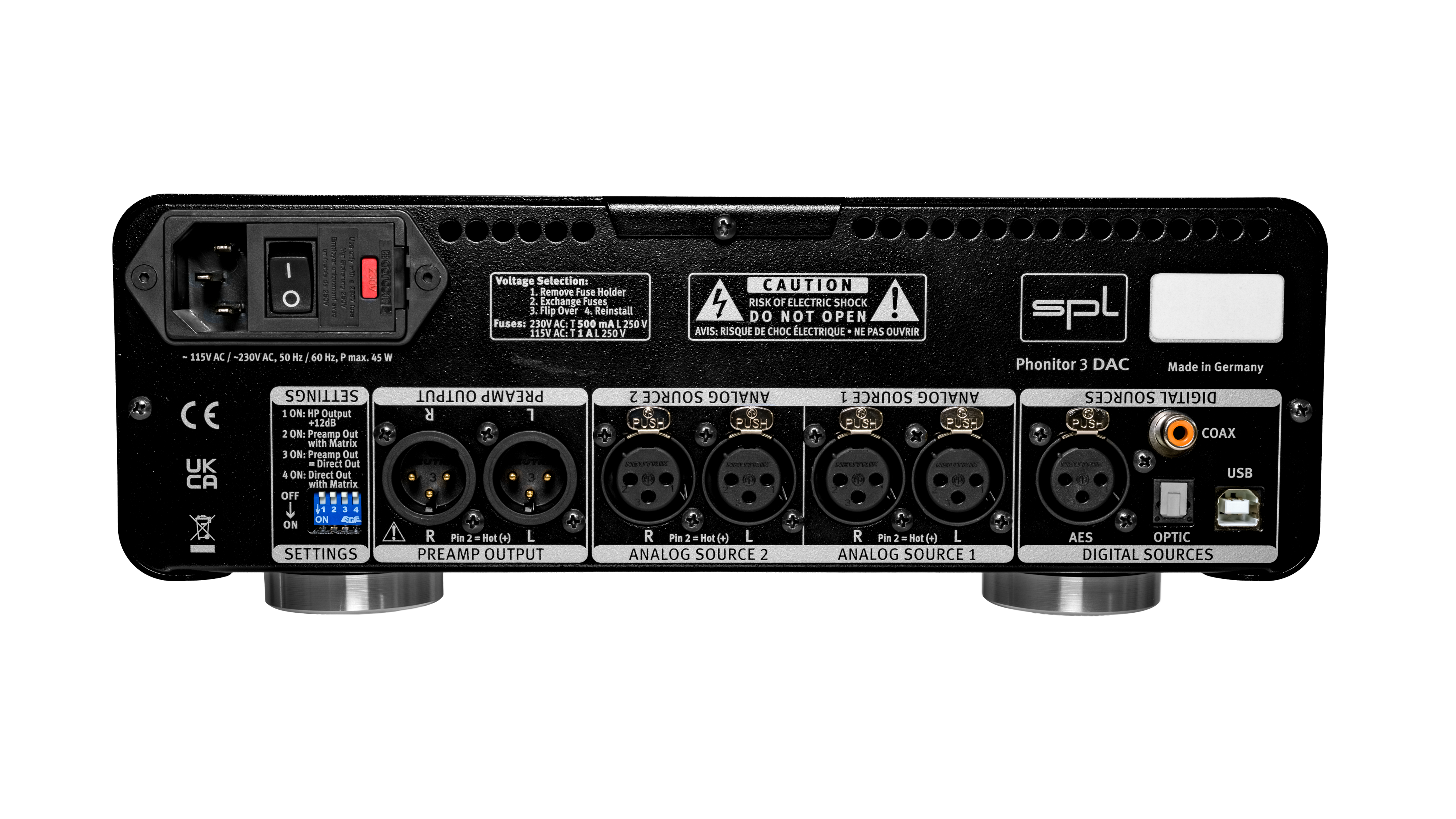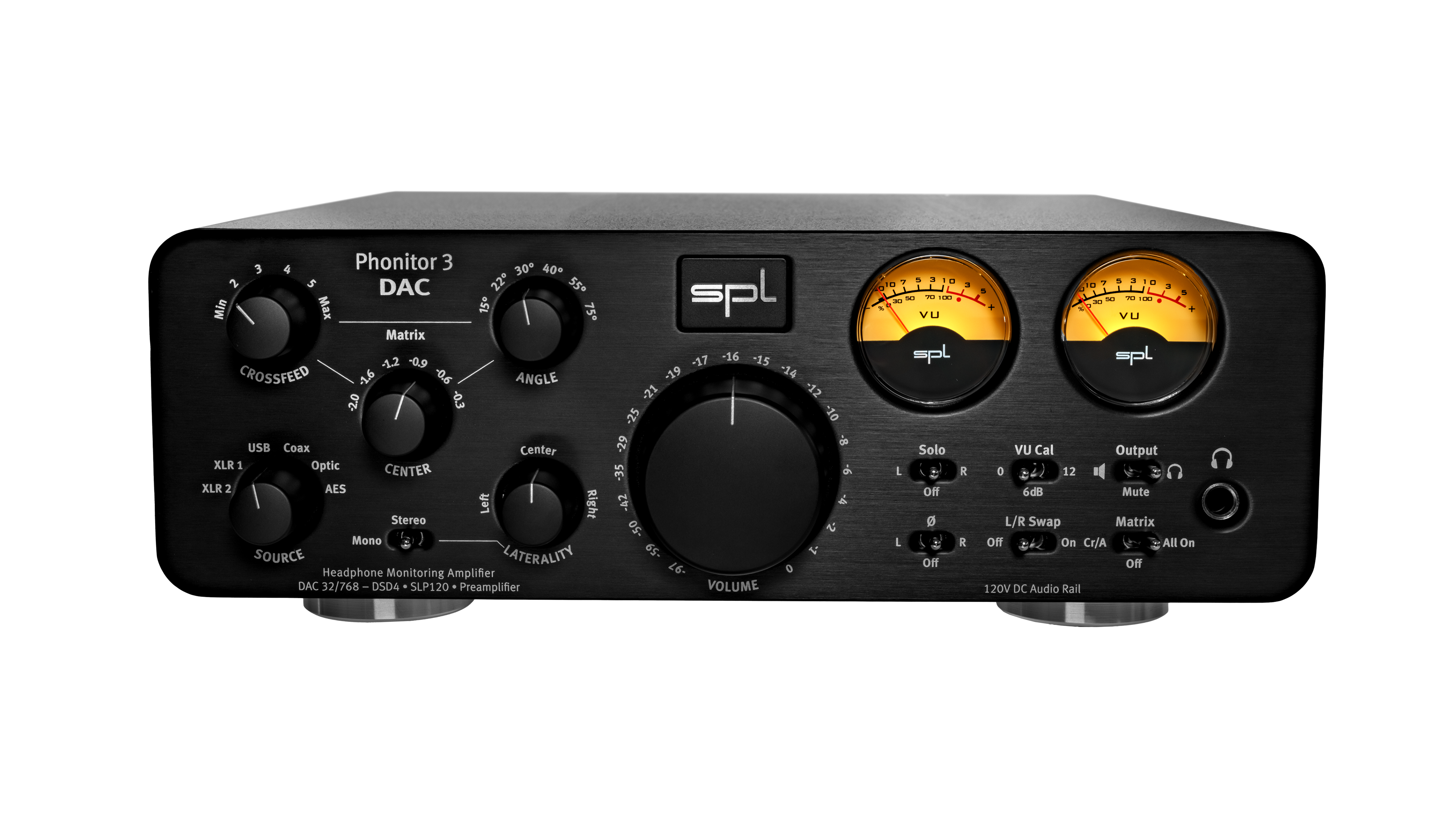Phonitor 3 DAC
The headphone amplifier, monitoring controller and DAC with 120V technology
Phonitor 3 DAC is not only the ultimate headphone amplifier and monitoring controller with
120V technology – the integrated DAC makes it the perfect monitoring centerpiece for demanding
producers as well as sound and mastering engineers working with digital sources or in the DAW.
Whether if USB, AES/EBU or S/PDIF – the integrated DAC with analog SLP120 converts digital
PCM audio signals with a resolution of 32 bit and a sampling rate of up to 768 kHz. It converts
DSD signals with a resolution of up to DSD256.
On the analog side, the Phonitor 3 DAC, based on the SPL 120V technology, offers the same
monitoring quality as the big SPL mastering consoles – on loudspeakers and headphones.
The analog Phonitor Matrix allows mixing and mastering on headphones in the highest quality –
with the same spatial perception of the stereo stage as on loudspeakers.
Great sound – for headphones
The Phonitor 3 DAC offers connection for a standard headphone with a stereo jack plug on the front. Thanks to the enormous output power, all kind of headphones are driven effortlessly. Thus, it plays out the advantages of the SPL 120V technology and rewards the listener with an honest, detailed and at the same time vivid sound experience.
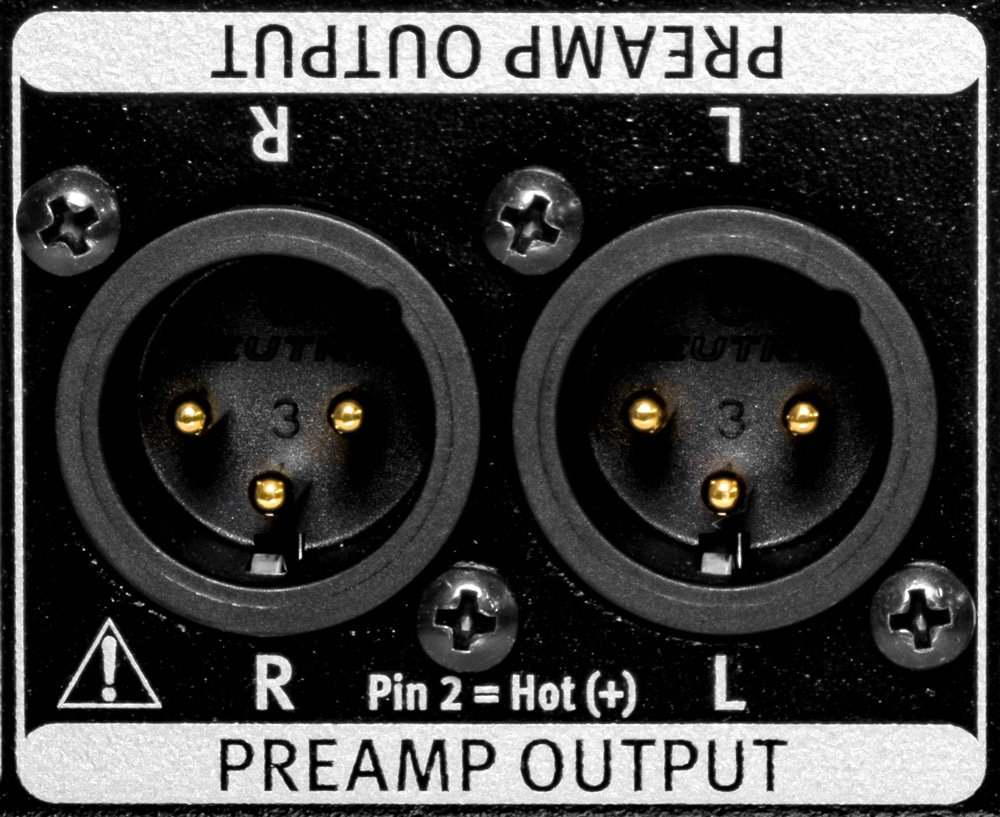
Great sound – also for loudspeakers
On the rear of the device, Phonitor 3 DAC offers
a stereo output which makes it a high-quality
monitoring controller for any monitoring situation. Active speakers with an integrated power amplifier
or passive speakers in combination with a power amplifier can be connected at this output.
Monitoring at the highest level
Phonitor 3 DAC offers the same key technology –
SPL 120V technology – and signal quality as the
big SPL DMC and MMC mastering consoles.
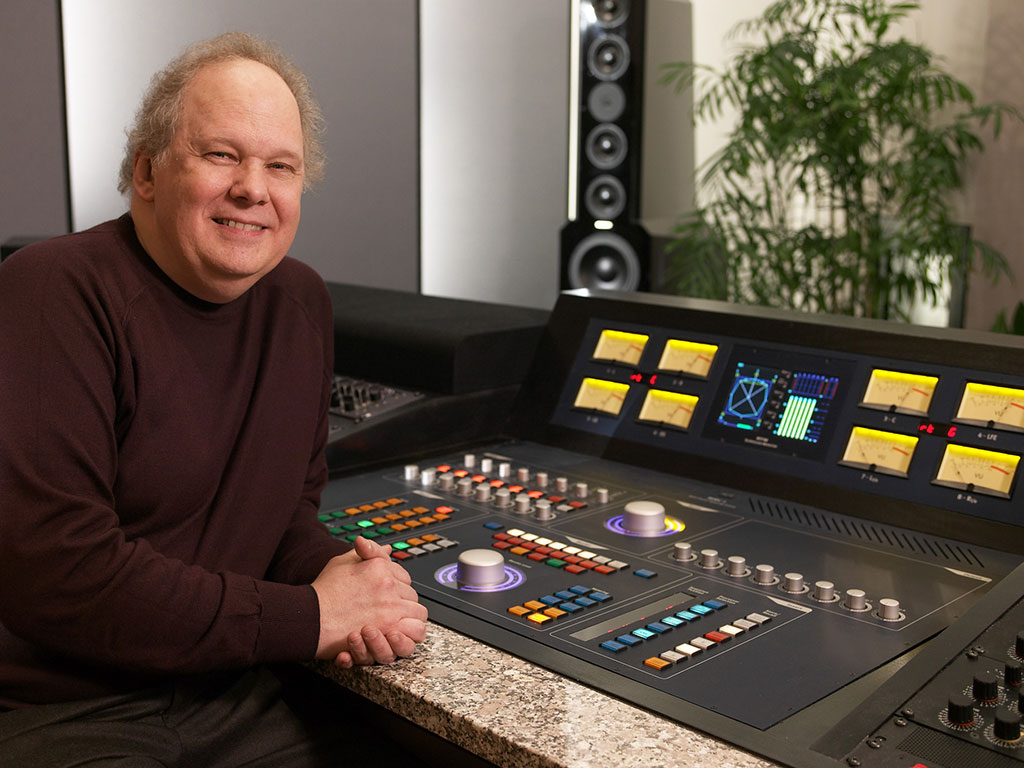 Bob Ludwig at his SPL MMC 1
Bob Ludwig at his SPL MMC 1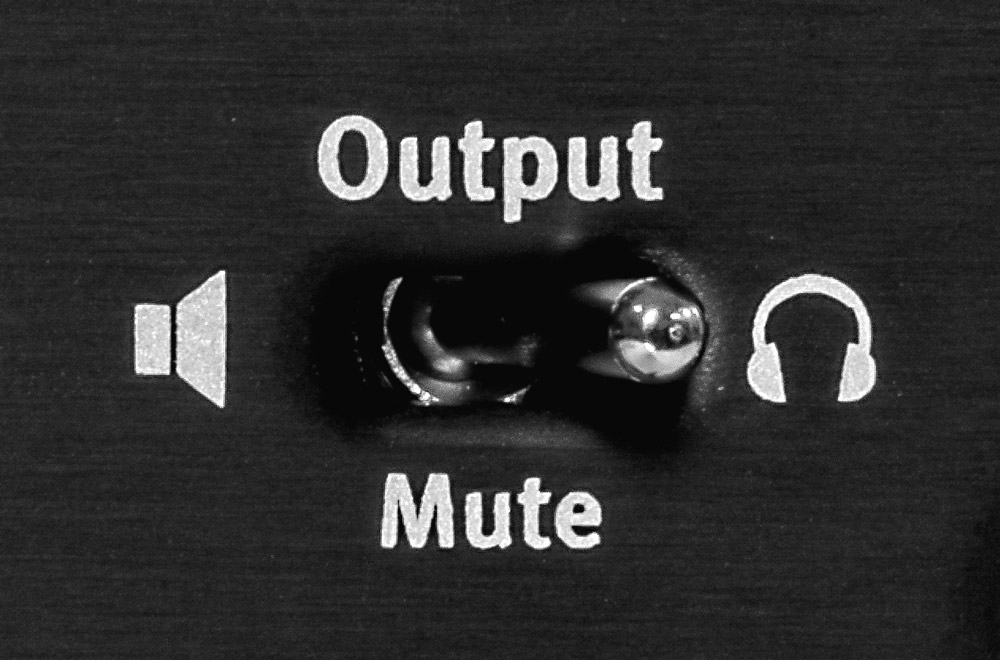
Headphones or Speakers
The Output switch – simply switch from headphone to speaker playback. In the center position (Mute), no signal reaches the outputs. The VU meters light up red.
Digital & analog stereo inputs – free choice
Up to six stereo sources can be connected to the Phonitor 3 DAC.
The source is selected via the Source switch.
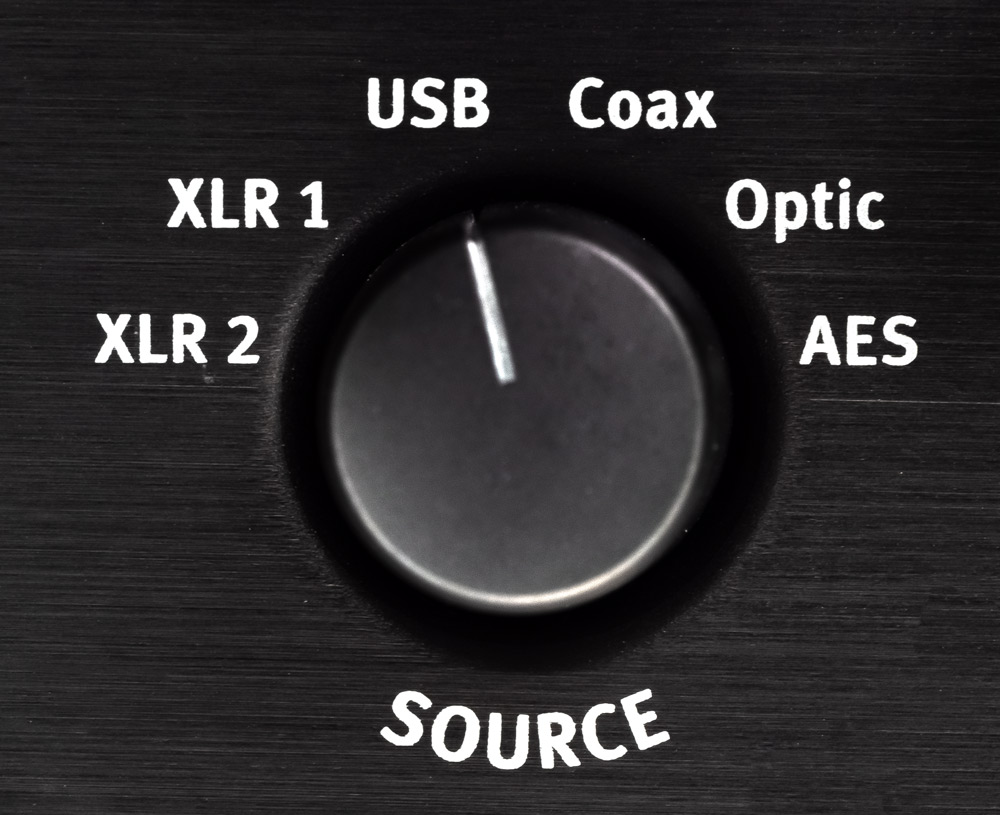
Analog inputs
On the analog side, two analog stereo inputs are offered, each with two XLR line inputs. Professional analog players with balanced outputs and line level can be connected here.
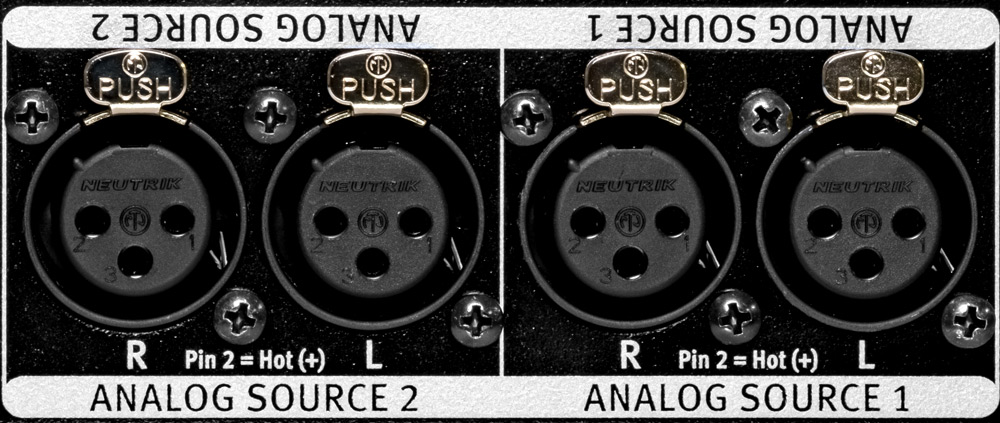
Digital inputs
On the digital side, the Phonitor 3 DAC offers four digital stereo inputs.
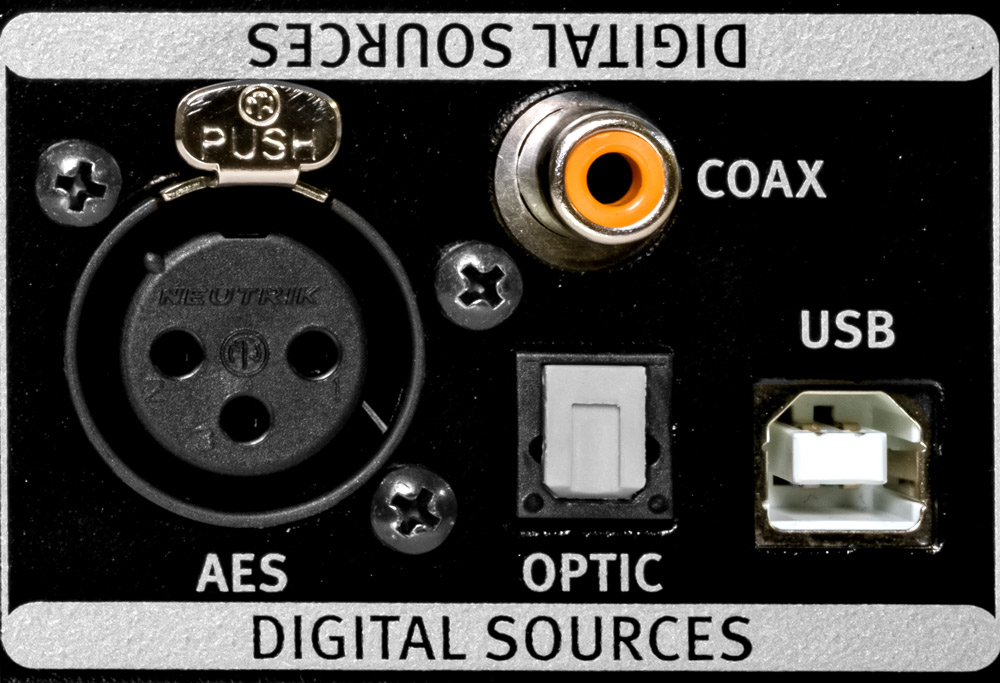
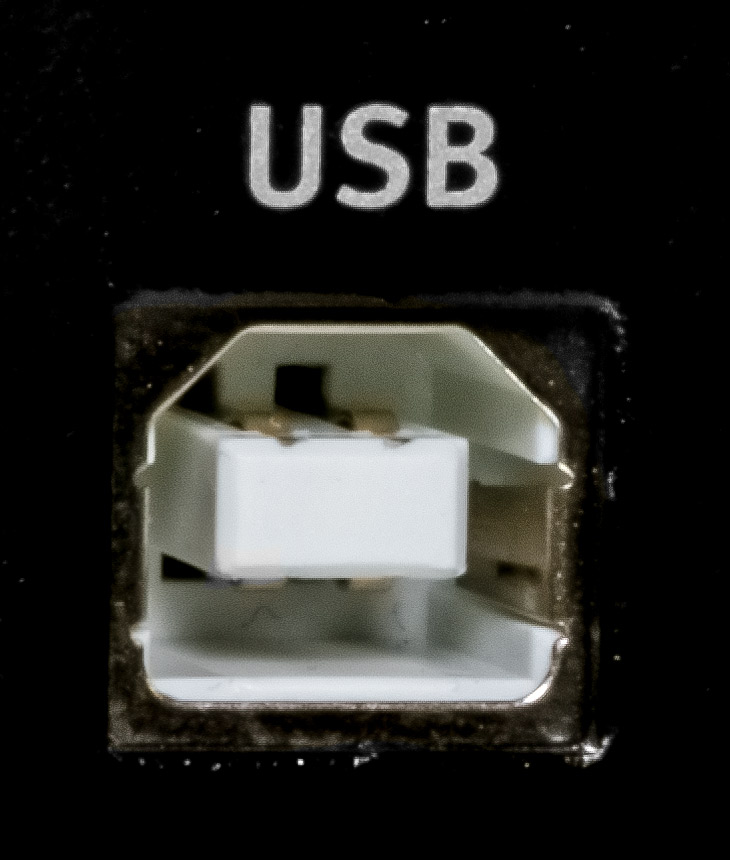
USB
The USB input (type B) can be used to directly connect the DAW. No driver installation is required for operation with a Mac or an iDevice. Via USB, the Phonitor 3 DAC converts PCM audio signals with a resolution of 32 bits and a sampling rate of up to 768 kHz as well as DSD signals with a resolution of up to DSD256.
S/PDIF, coaxial
The Input S/PDIF coaxial can also receive a two-channel signal (PCM audio) with sampling rates up to 192 kHz and a bit rate of 16 bits to 24 bits. Unbalanced, 2-wire 75-ohm coaxial cables with RCA connectors are used for signal transmission.
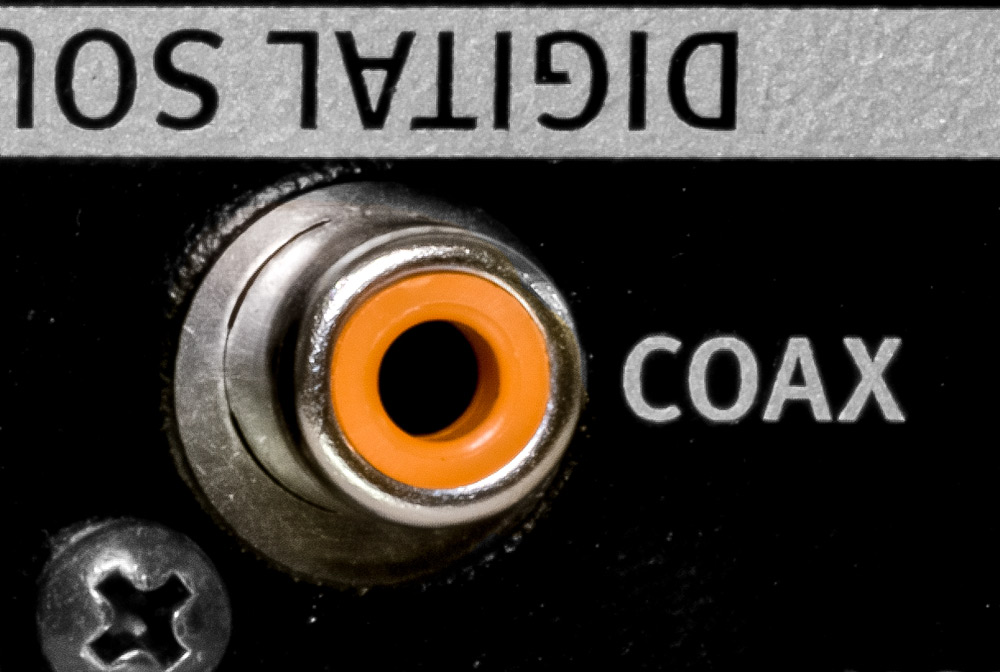
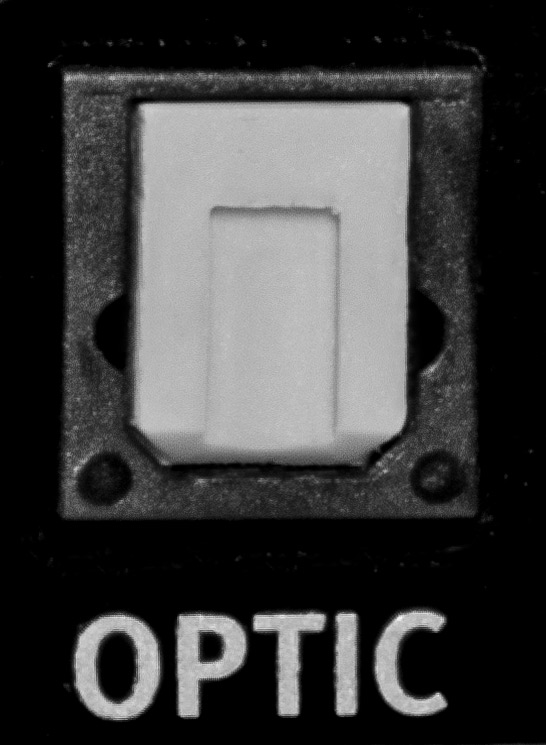
S/PDIF, optical
The S/PDIF optical input can also receive a two-channel signal (PCM audio) with sampling rates of up to 192 kHz and a bit rate of 16 bit to 24 bit. The input jack is an F05 jack. This interface is better known under the Toshiba brand name TOSLINK.
Tip: You should attach importance to the quality of the optical fiber. With inexpensive plastic optical fibers, transmissions with quad sampling rates (176.4kHz/192kHz) may have faults. In this case a glass fiber optic cable should be chosen.
AES/EBU
The AES input provides an input jack which corresponds to a standard XLR input (XLR, female). An AES signal can transport two encoded PCM audio channels with a maximum sampling rate of 192 kHz and a bit rate of 16 bits to 24 bits. This standard is defined under IEC 60958 Type I. Balanced, 3-core, 110 Ohm “twisted pair” cables with XLR plugs are used for connection.
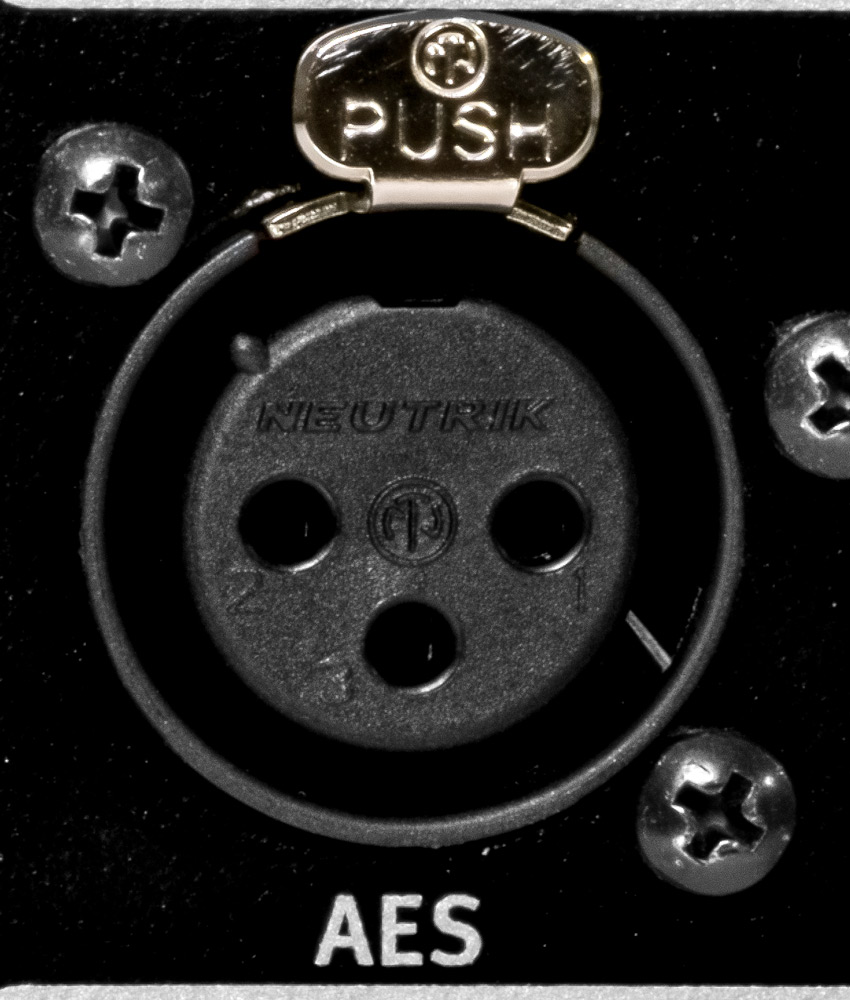
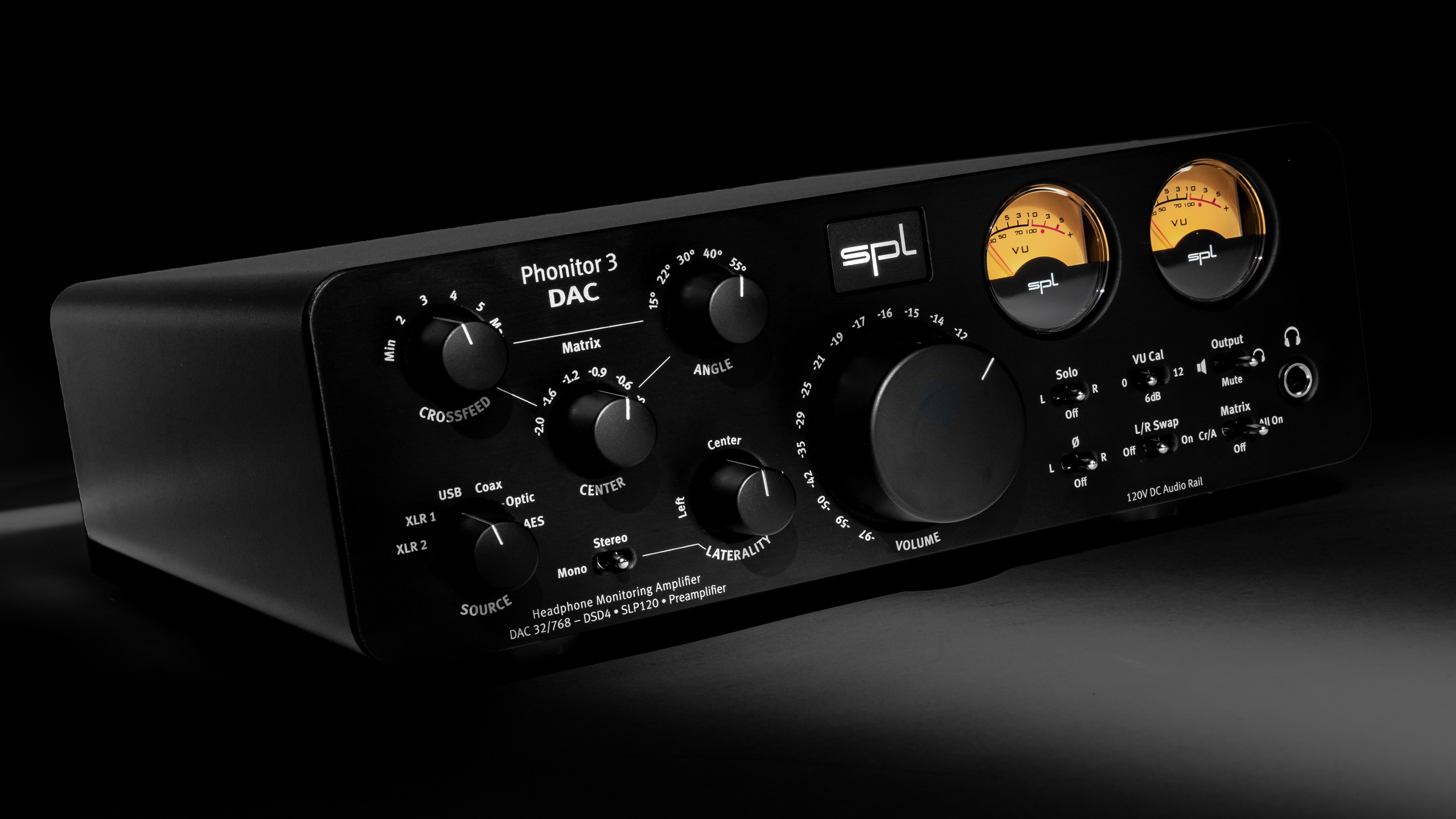
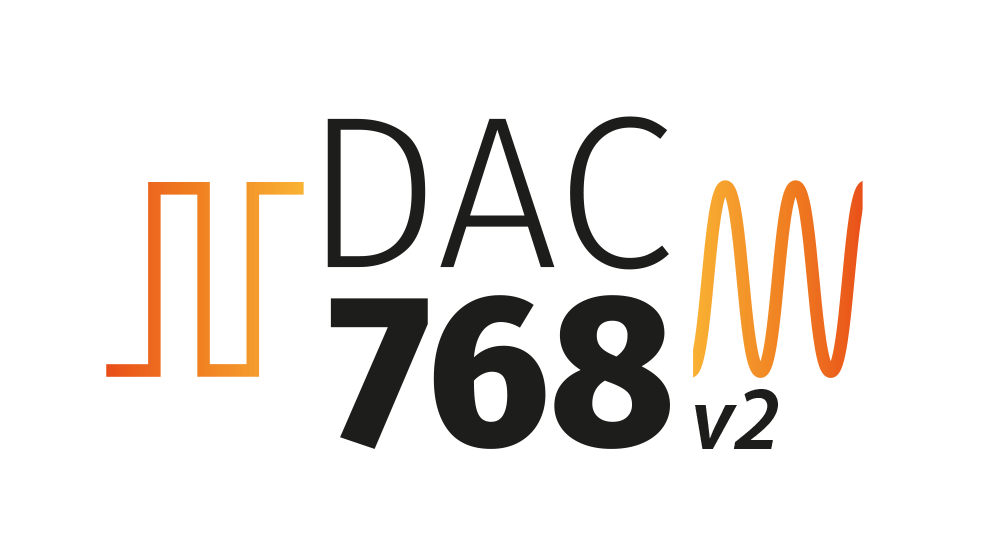
The DAC768v2 – Only the best is good enough
The converter chip in the Phonitor 3 DAC’s digital/analog converter is the highly acclaimed AKM AK4493 SEQ VELVETSOUNDTM premium DAC chip in the latest version of the SPL DAC “DAC768v2”, which thanks to its architecture reproduces the finest sound details. It impresses with even lower distortion characteristics and a wider dynamic range than its predecessor.
It converts PCM audio with a resolution of 32 bits and a sampling rate of up to 768 kHz, which is equivalent to 16 times CD resolution. Direct Stream Digital is also supported up to a resolution of DSD4 or DSD256.
The DAC768v2 features the newest version of the Spartan FPGA – Spartan 7.
In contrast to the smaller SPL DAC “DAC768xs”, it not only offers an AES/EBU digital input, but also the new, optimized SPL SLP120 with 120V technology.
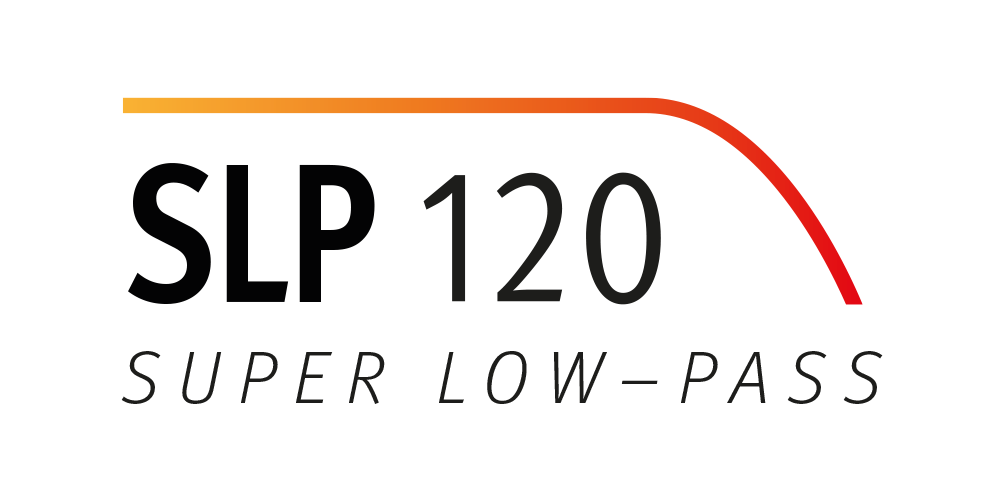
The SLP120 (Super Low-Pass)
The analog output of the DAC chip must be filtered by a low pass filter. In contrast to all other DACs in the world, the low pass filters here are built using 120V technology, which provides a plus in dynamics and headroom and sound. The filter specially optimized for the new SPL DAC768v2 is called SLP120 (Super Low-Pass).
The DAC768v2 inside the Phonitor 3 DAC is equipped with the SLP120 – an analog “Super Low-Pass” filter with 120V technology.
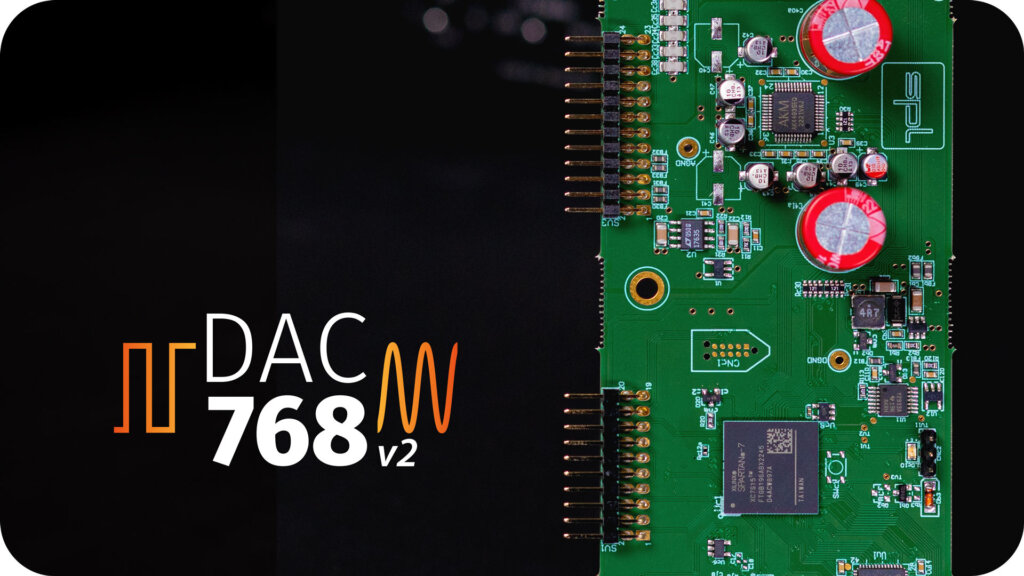
DAC768v2 – what's new:
1. AK 4493 SEQ
The DAC768v2 is equipped with the latest generation of the premium DAC chip – the AK 4493 SEQ – from Asahi Kasei (previously AK 4490).
The AK 4493 SEQ not only supports the playback of PCM signals at up to 768 kHz and DSD signals up to DSD512 – this 32-bit stereo DAC with “VELVETSOUND™ technology” impresses with even lower distortion characteristics and a wider dynamic range than its predecessor.
2. Spartan 7
The DAC768v2 features the newest version of the Spartan FPGA – Spartan 7 (previously Spartan 6).
3. The newest generation of the SPL low-pass filter “SLP120”
The DAC768v2 comes with a completely new tuned low-pass filter, which perfectly matches the sonic strengths of the new converter chip. It ofers an even better representation of the stereo image as well as a three-dimensionality we never experienced from any other DAC before.
The new DAC revision can be recognized by the “DAC768v2” label on the serial number sticker.
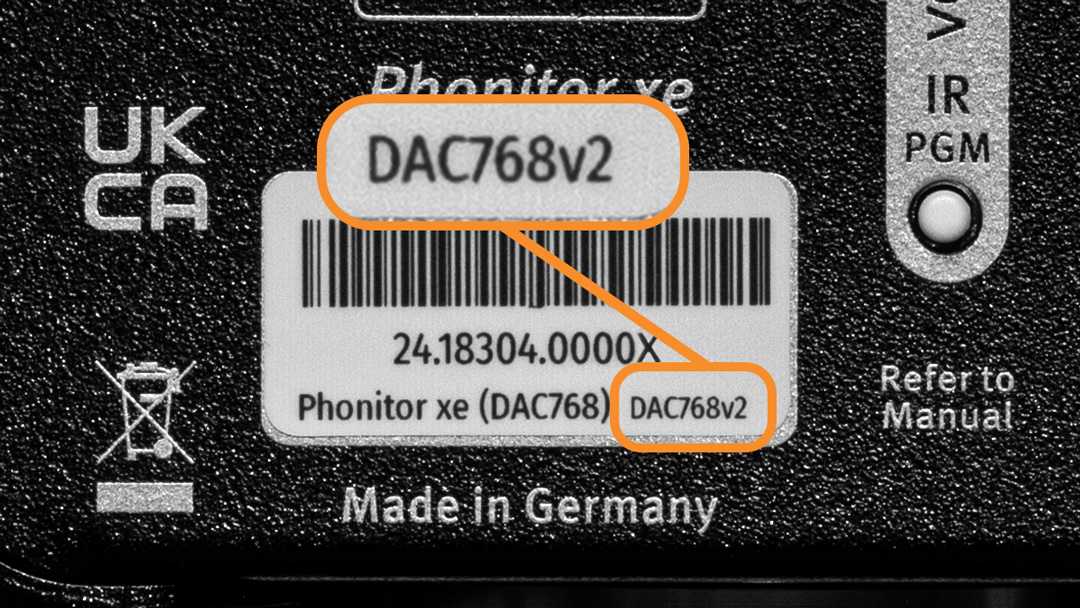
The design of the DAC768v2 is unfortunately not compatible with devices that were built with DAC768.
In addition to the original DAC chip (previously AK4490, now AK4493), other components in the digital environment that are no longer available, such as the previously used version of the Spartan-6 FPGA (now Spartan-7), had to be updated. As the technical characteristics of these components are different from those of their predecessors, further technical adjustments had to be made to the device in order to achieve the best possible sonic performance of which SPL is known for. The analog low-pass filter with 120V technology is also different in the devices with DAC768v2.
It is therefore not possible to simply replace the DAC768 module with the DAC768v2 module.
Milled from solid
The massive 45mm volume control knob milled from aluminum is a haptic highlight. Its mass together with the Alps RK27 “Big Blue” potentiometer enhances the “spoon in the honey” feeling even further and provides perfect control of the monitoring level.
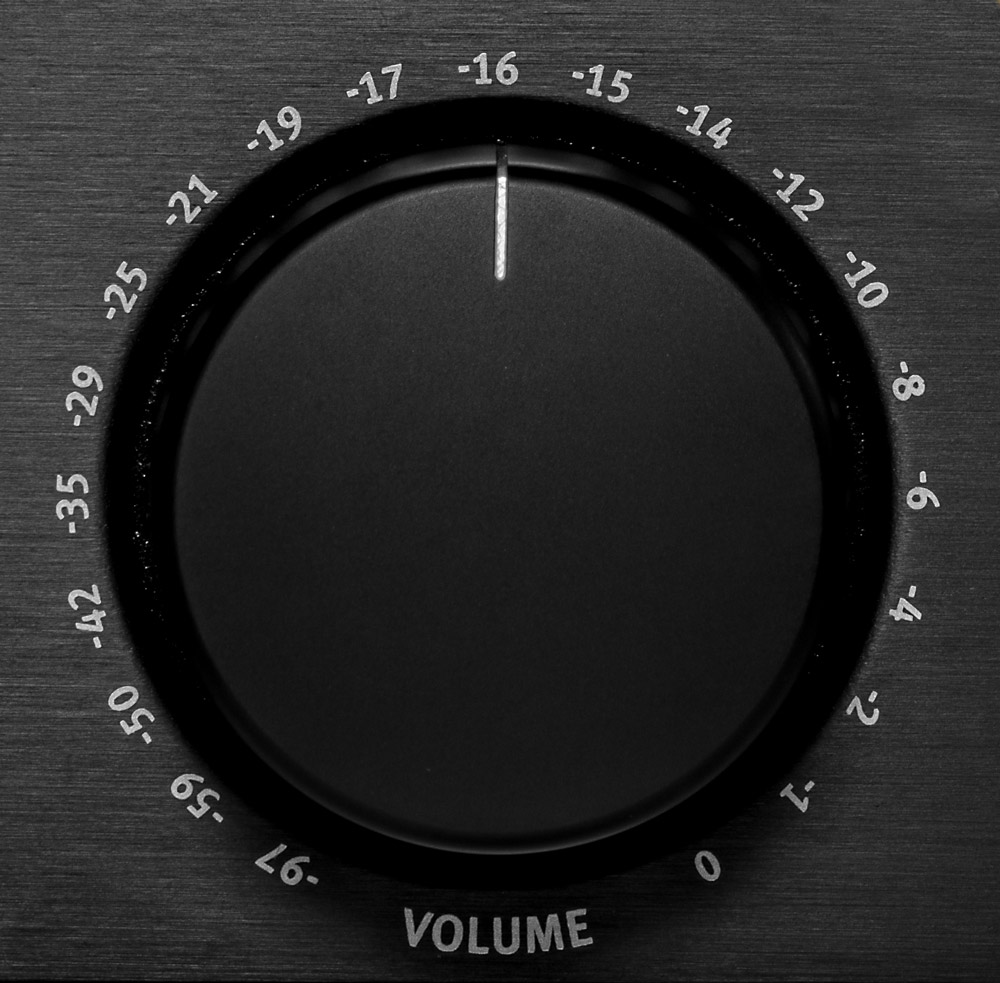
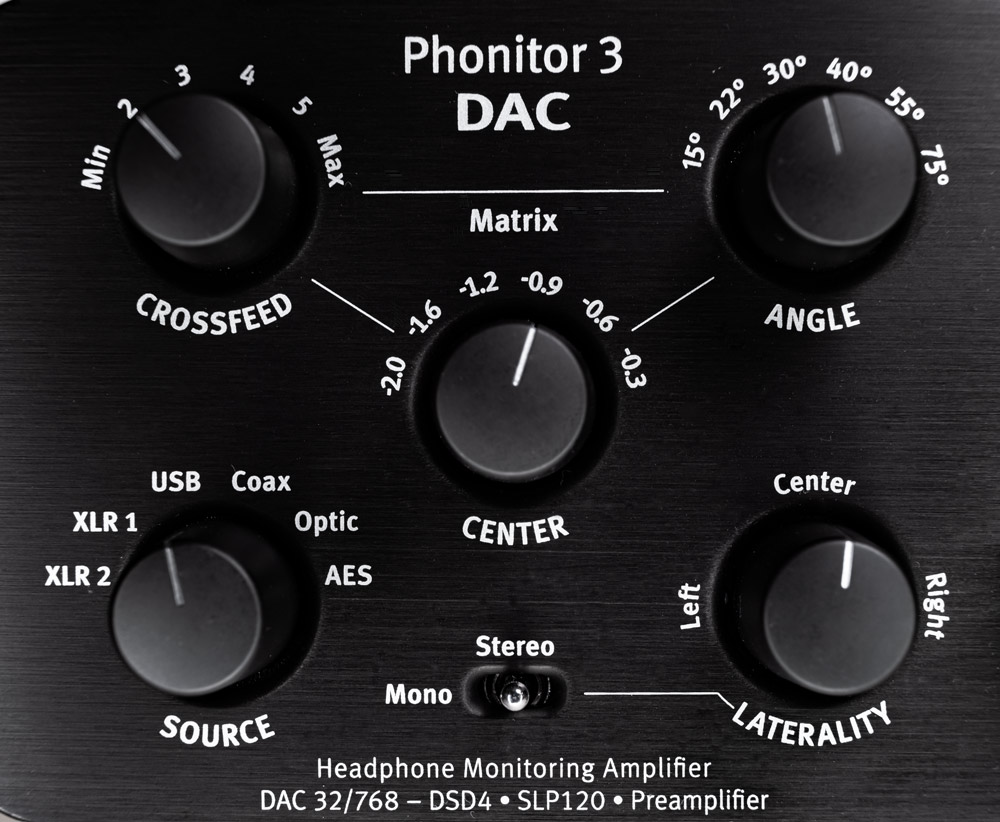
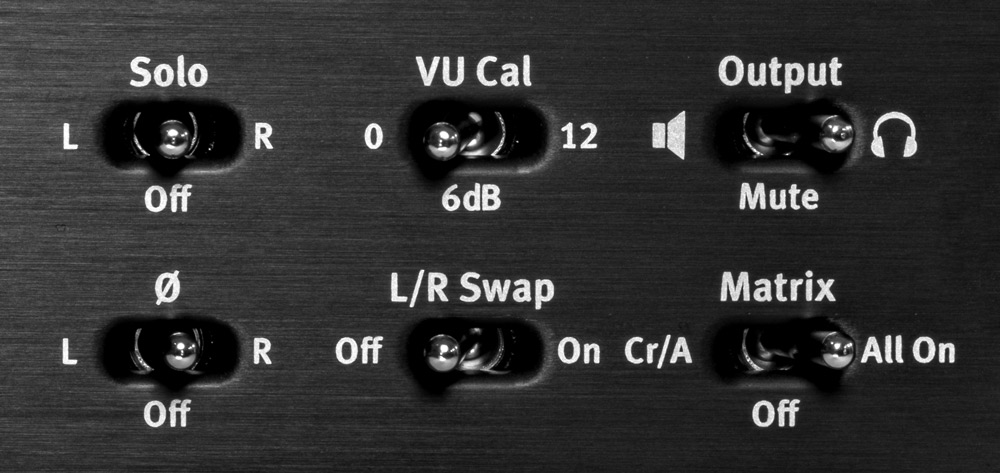
Monitoring without any compromises
The Phonitor 3 DAC is a full-fledged
monitor controller:
- Source selection
- Phonitor Matrix with Crossfeed, Speaker Angle and Center Level (the latter can be switched off)
- Mono/Stereo
- Laterality control
- Solo L/R
- Phase inversion for L and R
- L/R Swap
- Output switchable to headphones or speakers
- Mute
Mono or stereo – a matter of setting
The Mono/Stereo switch can be used to select whether the output signal of the Phonitor 3 DAC is a regular stereo signal or whether it is summed to a mono signal.
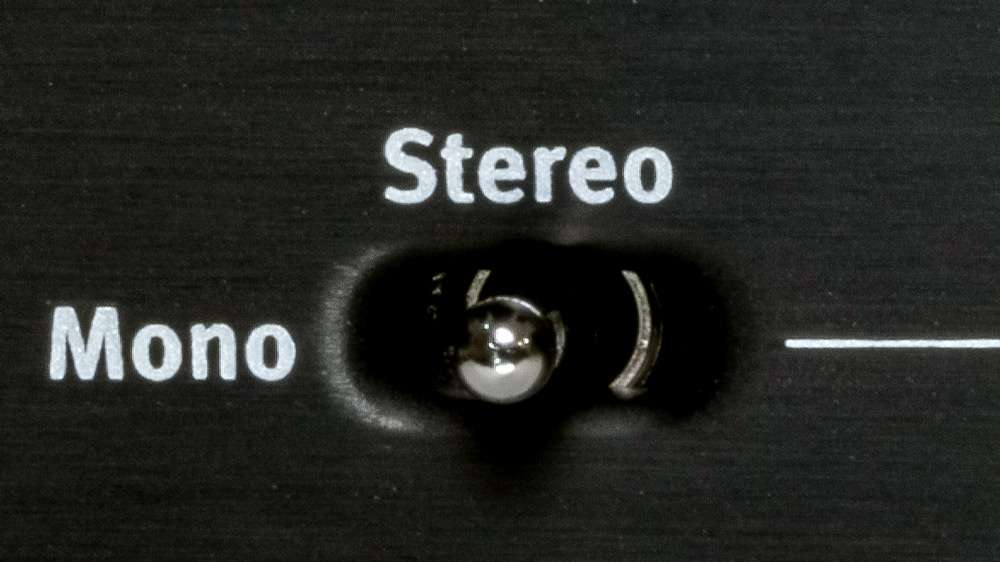
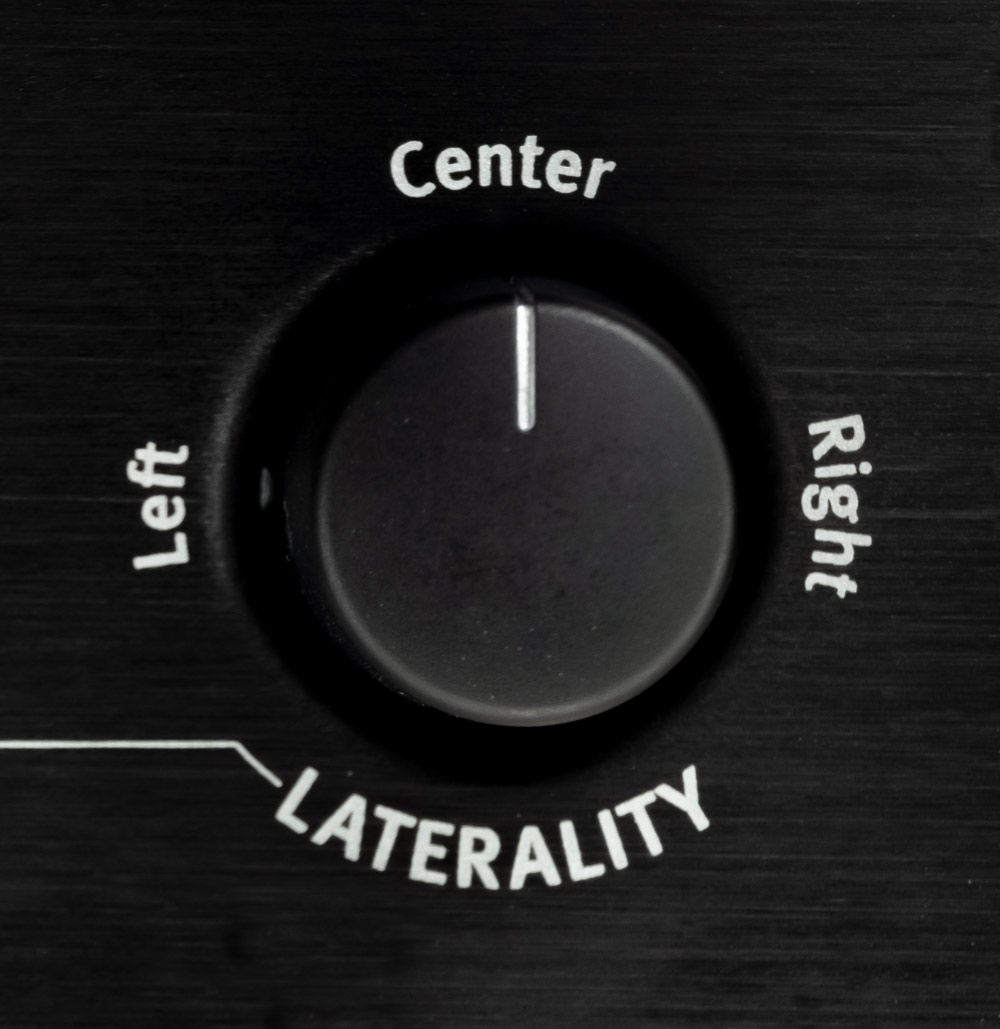
Finding the real center
Naturally, hearing can be directed more to the left or more to the right.
This becomes particularly clear when listening on headphones.
Therefore, the Phonitor 3 DAC has the uniquely finely resolved laterality control, which rebalances the stereo image on the monitoring side.
The Mono/Stereo switch can not only be used to switch between stereo or mono playback. This switch is also used to activate or deactivate the laterality control.
Solo L/R
Only the right or left channel of the audio signal should be played back?
The Solo L/R function makes it possible. If the triple selection switch is
in the “L” position, only the left channel is played back – if it is in the “R” position, only the right channel is played back. In the middle position “Off” the Solo function is switched off. The regular stereo signal consisting of the left and right channel is thus present at the output of the Phonitor 3 DAC.
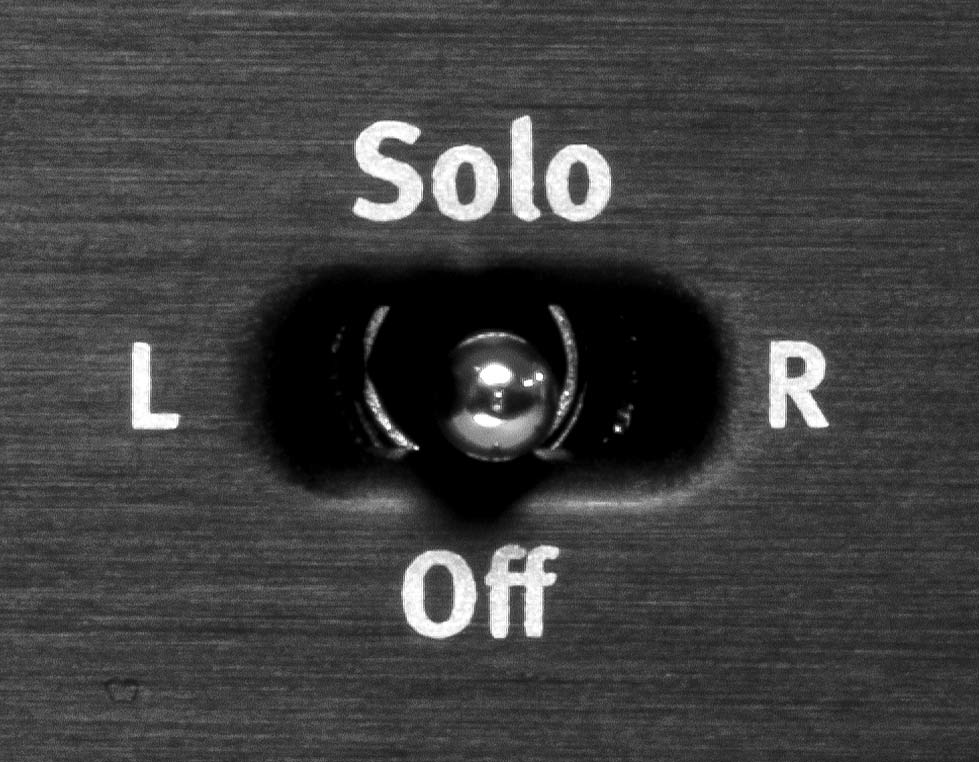
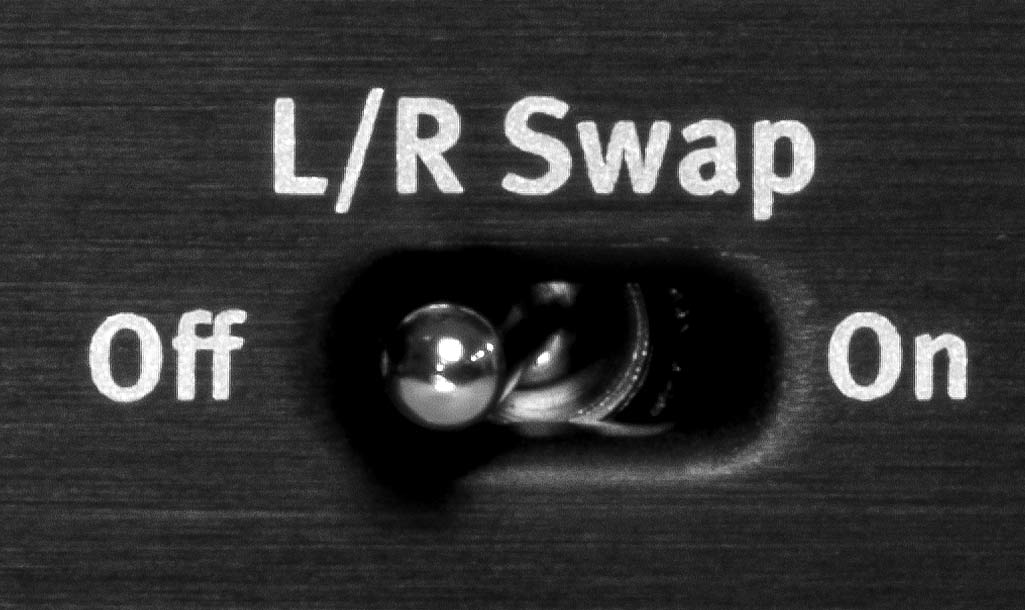
L/R Swap
A special feature is the channel swap function: L/R Swap.
This function inverts the stereo image. Left becomes right and right
becomes left. This is especially important and extremely time-saving, when you are monitoring samples in video dubbing that should match a scene with direction of movement. If the direction is not correct, you usually have to load the sample into the DAW to switch channels. before you can judge whether the sample matches the image. With the L/R Swap function, this is no longer necessary. You can now adjust the direction of movement on the Phonitor 3 DAC while pre-listening the sample library.
Phase inversion for L and R
With this switch the phase of the left or right channel of the audio signal can be inverted. If the three-way selection switch is in the “L” position, the left channel is inverted – if it is in the “R” position, the right channel is inverted. In the middle position “Off” this function is switched off. At the output of the Phonitor 3 DAC the regular stereo signal is thus present.
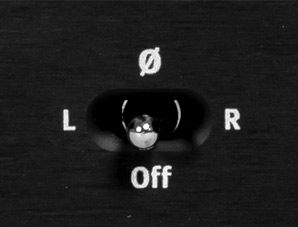


M/S – Mid or Side?
By using the mono/stereo and L/R phase inversion switch in combination, it is also possible to only monitor the mid or side signal. When the switch is set to “Mono” and phase inversion is active for L (or R), only the side signal is played back.
If the phase inversion is switched off, the mono signal corresponding to the “M” signal is played back. Separate monitoring of the M and S signals has become a widespread standard for many mixing and mastering engineers.
Everything at a glance
Two mechanical VU meters visualize the input levels for the left and right audio channels.
The “VU Cal” switch can be used to reduce the signal visualized on the VU meters by -6 dB or -12 dB.
Thus, the VU meters operate in the ideal display range even at very high input levels.
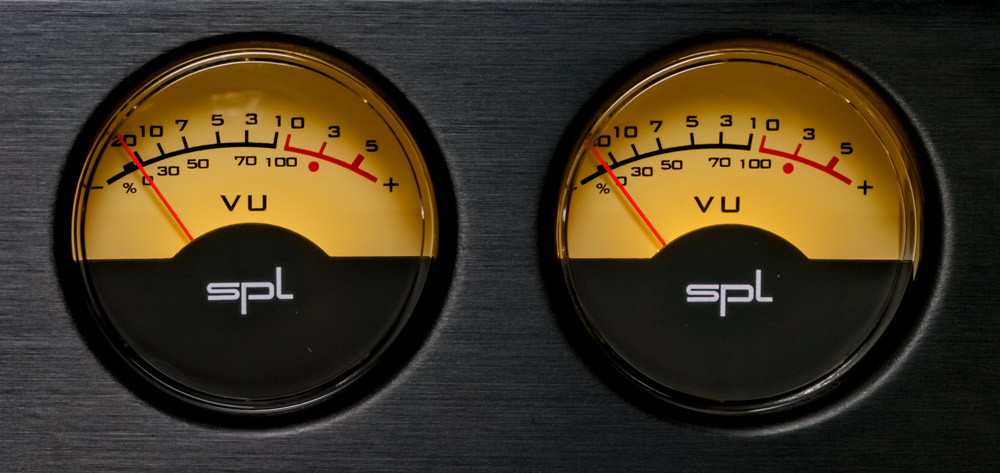
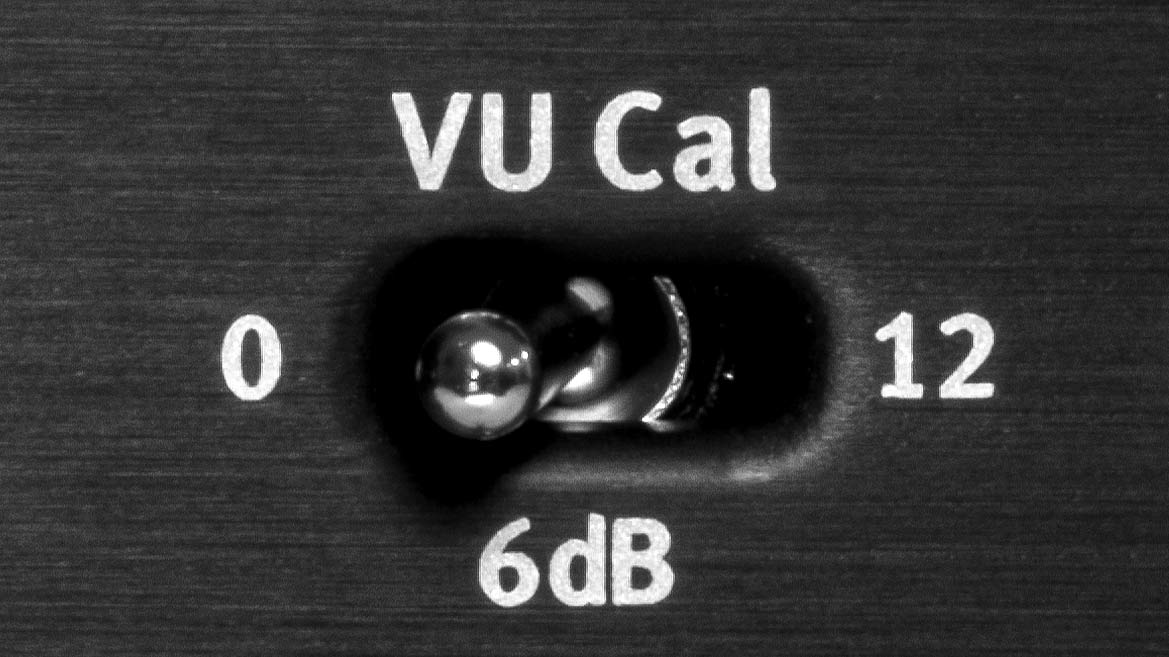
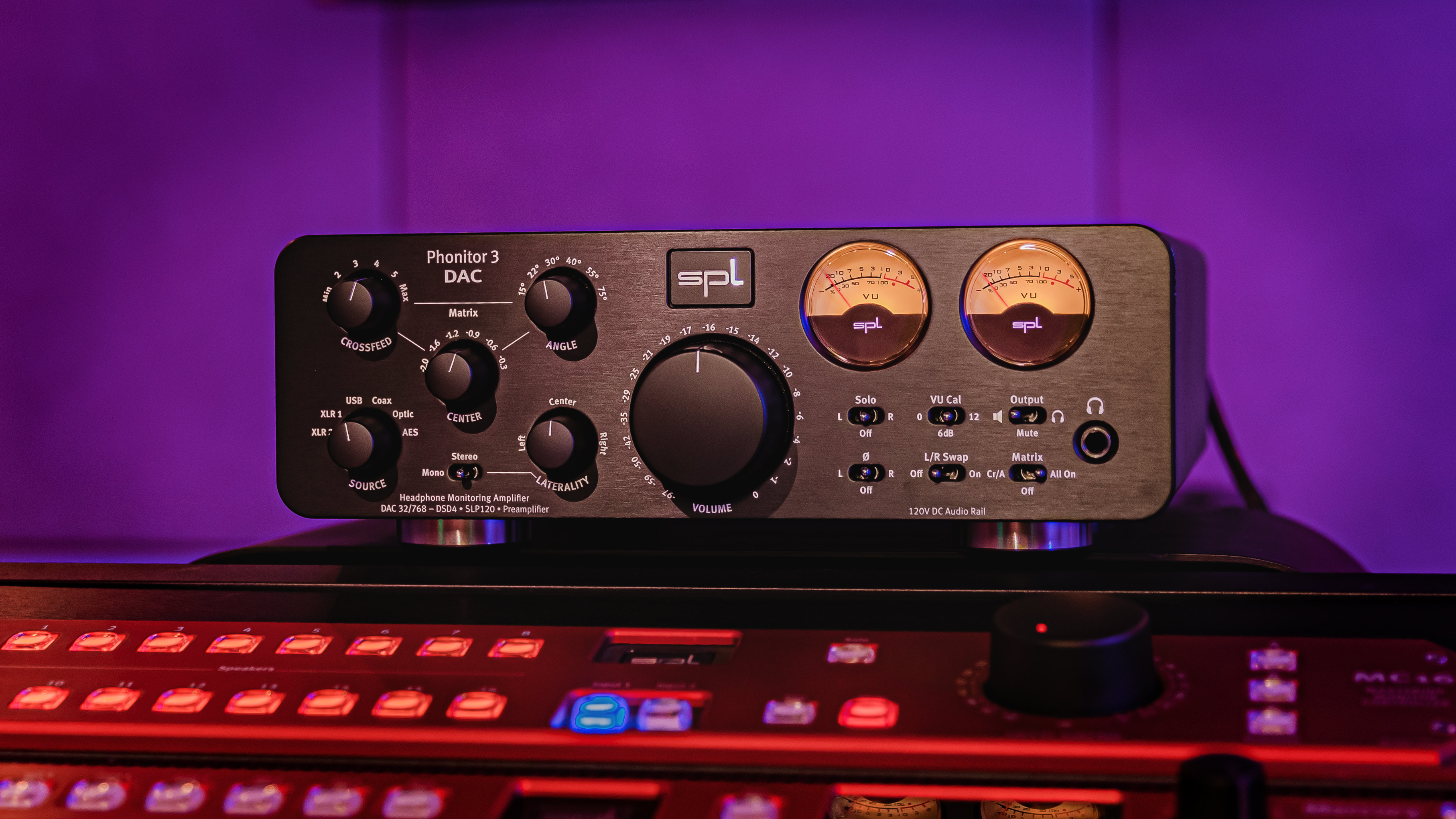
The Revolution: Phonitor Matrix
The Phonitor Matrix is the revolution in the headphone amplifier.
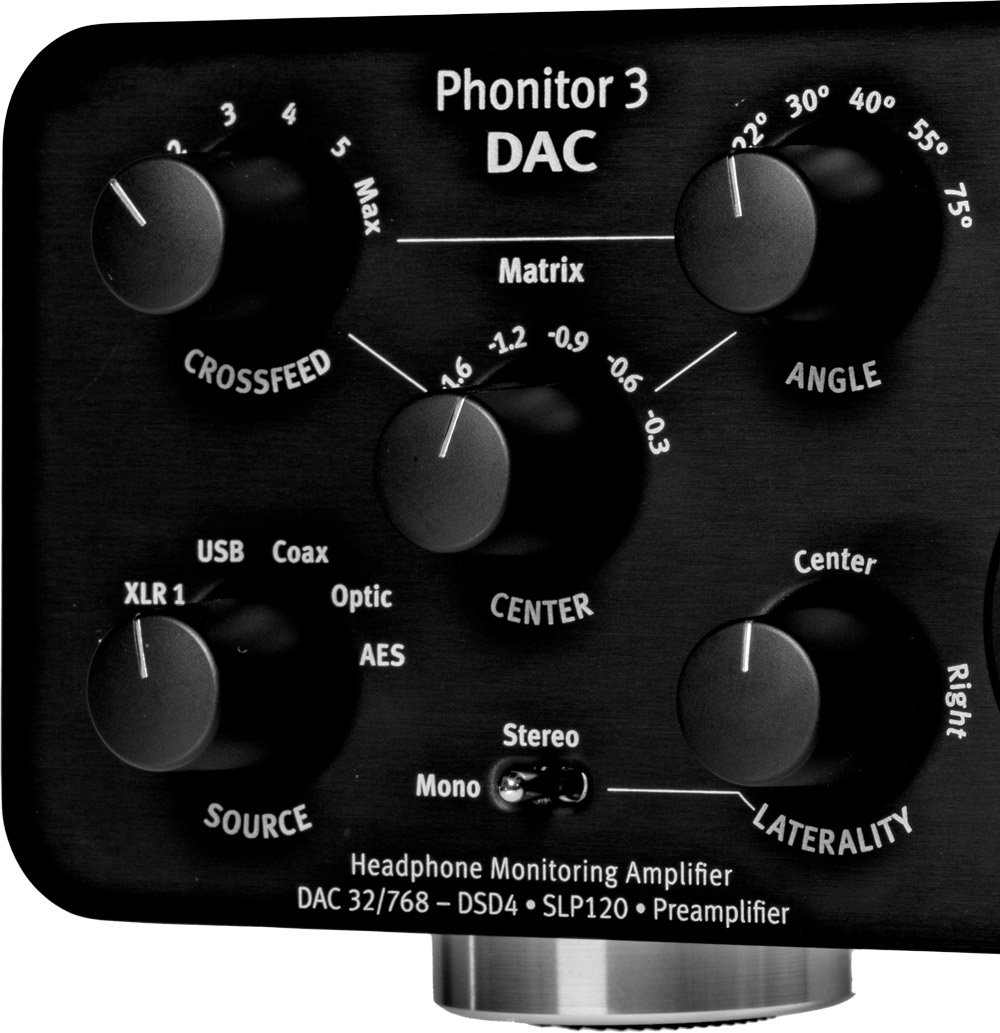
One of the unique features of SPL headphone amplifiers is the SPL Phonitor Matrix. It enables mixing and mastering engineers to create perfect mixes on headphones, which will translate perfectly to all types of stereo speaker systems.
But the Phonitor Matrix is not only designed for professional use in the studio. It also enables the hifi enthusiast to enjoy music on headphones, like if it was played back on speakers.

Correct
The SPL Phonitor Matrix will correct this false stereo image with an analog circuitry and ensures a correct representation of the stereo image and a relaxed listening experience.
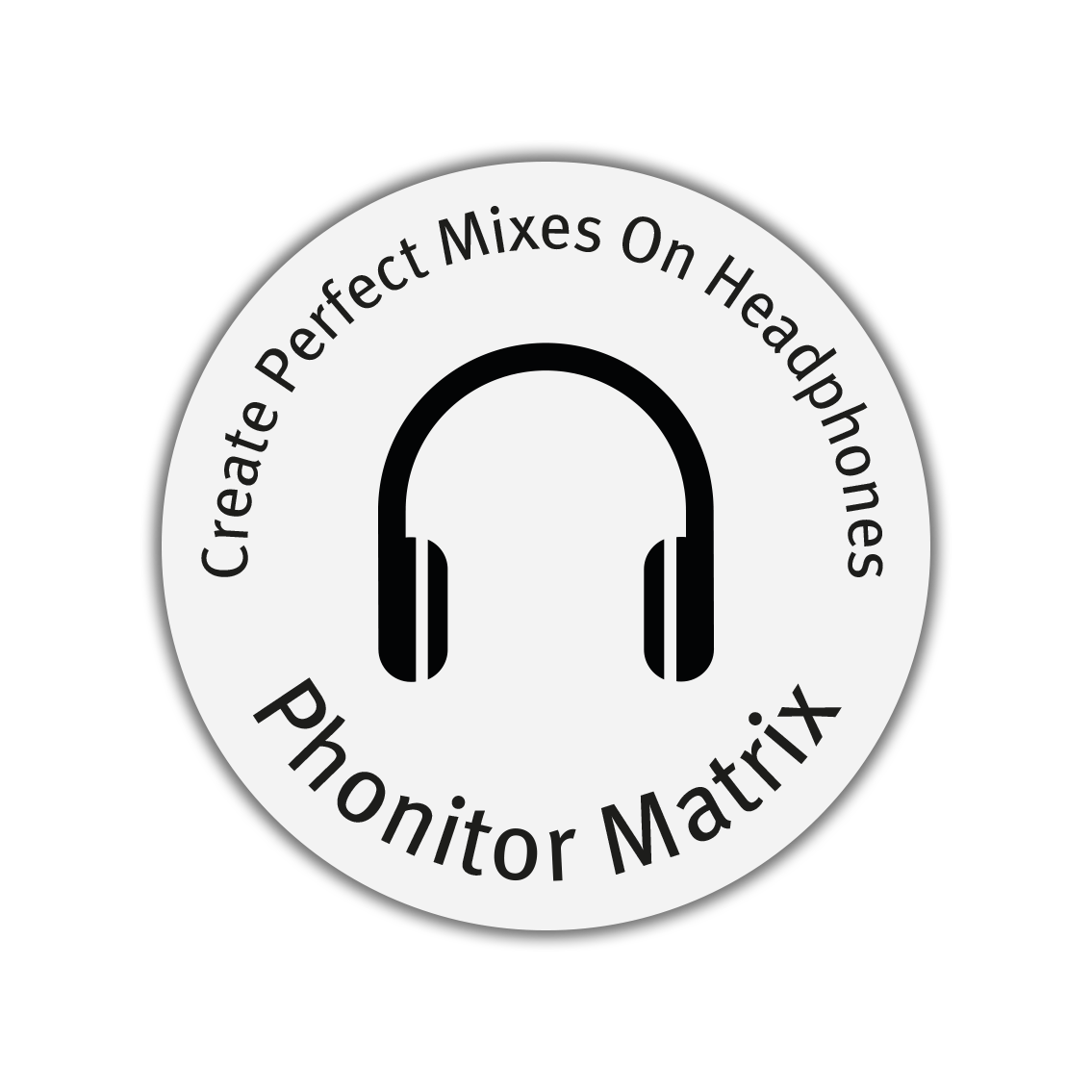
Phonitor Matrix
The Phonitor Matrix allows the mixing and mastering audio engineer to create perfect mixes on headphones that sound great on all types of stereo speaker systems.
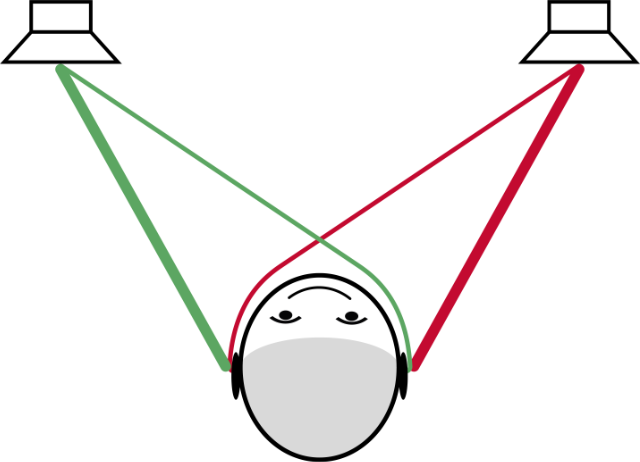
Crossfeed
Listening on headphones is different from listening on loudspeakers.
The biggest difference is the lack of crossing signals of the sound signal from the left speaker to the right ear and from the right speaker to the left ear.

Conventional
This results in an unnaturally wide and
wrong stereo image.
The various sound sources of the audio signal are not localized as the sound engineer intended them to.

Correct
The SPL Phonitor Matrix will correct this false stereo image with an analog circuitry and ensures a correct representation of the stereo image and a relaxed listening experience.

Phonitor Matrix
The Phonitor Matrix allows the mixing and mastering audio engineer to create perfect mixes on headphones that sound great on all types of stereo speaker systems.

Crossfeed
Listening on headphones is different from listening on loudspeakers.
The biggest difference is the lack of crossing signals of the sound signal from the left speaker to the right ear and from the right speaker to the left ear.

Conventional
This results in an unnaturally wide and
wrong stereo image.
The various sound sources of the audio signal are not localized as the sound engineer intended them to.

Correct
The SPL Phonitor Matrix will correct this false stereo image with an analog circuitry and ensures a correct representation of the stereo image and a relaxed listening experience.
- 1
- 2
- 3
- 4
How is this possible?
Music is normally produced and mixed for playback on stereo speakers.
Listening on headphones is different from listening on loudspeakers. The biggest difference is the lack of crossing signals of the sound signal from the left speaker to the right ear and from the right speaker to the left ear.
These crossing signals are missing in conventional headphone listening, because there are no signals crossing from one side of the headphones to the other. This results in an unnaturally wide stereo stage and sound sources are not played back at their actual position in the stereo spectrum.
The SPL Phonitor Matrix can correct this false stereo image with an analog circuitry.
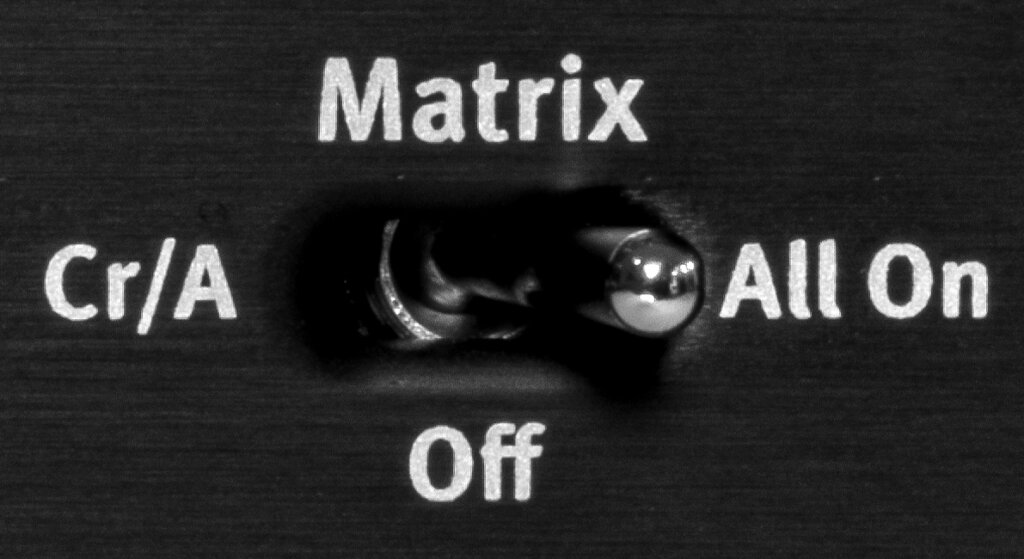
Phonitor Matrix settings
With the Matrix switch you can activate the Phonitor Matrix
– with the Center function (All) or without (Cr/A).
In the Off position, the Phonitor Matrix is deactivated.
The Phonitor Matrix creates a speaker-like listening experience on headphones, by mixing the left and right signals, each delayed (interaural time difference) and attenuated (interaural level difference), to the corresponding opposite side.
The two main parameters of the Phonitor Matrix are Crossfeed and Angle:
Crossfeed determines the crossing signals of the channels.
Angle determines the opening angle of the stereo image.
Crossfeed
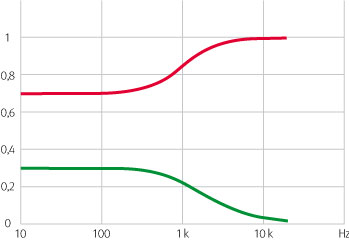
Level and frequency corrections of the right (red) and left audio channel (green) at maximum crossfeed.
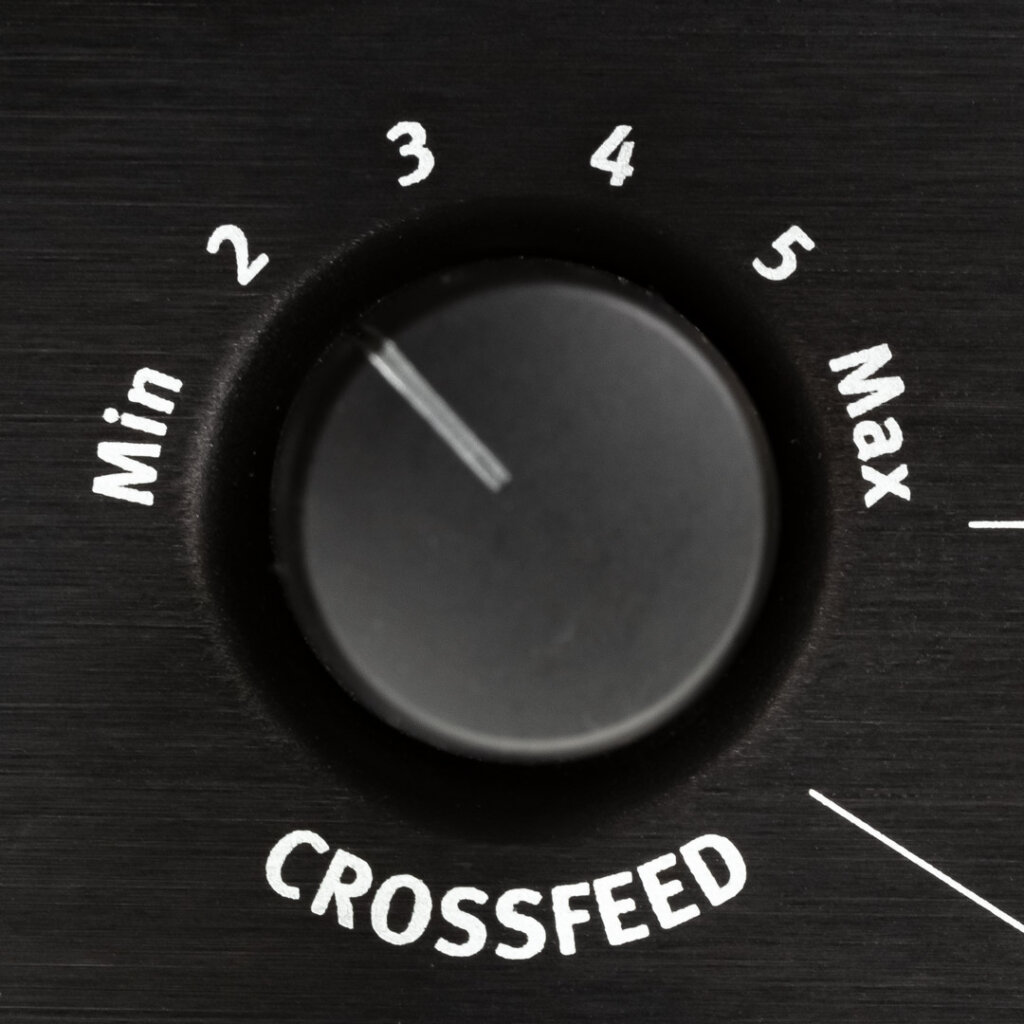
With the Crossfeed switch you can adjust the interaural level difference. The level difference is comparable to the influence of different room sizes and their reflection and absorption characteristics. The interaural level difference is frequency-corrected because the sound is reflected and absorbed by the head in a non-linear fashion.
Angle
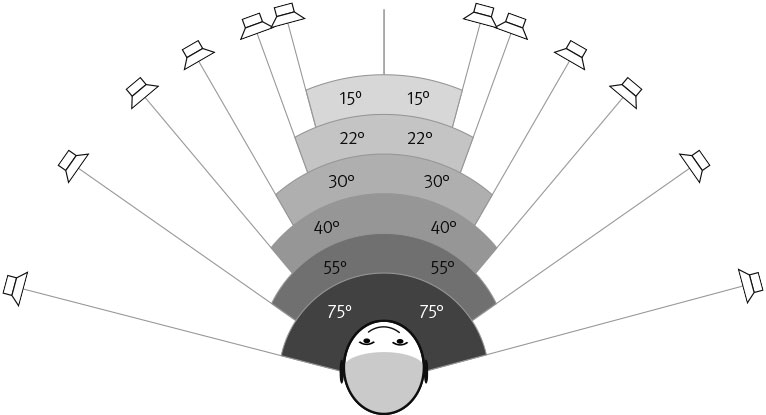
Settings for the speaker placement angle to determine the interaural time difference.
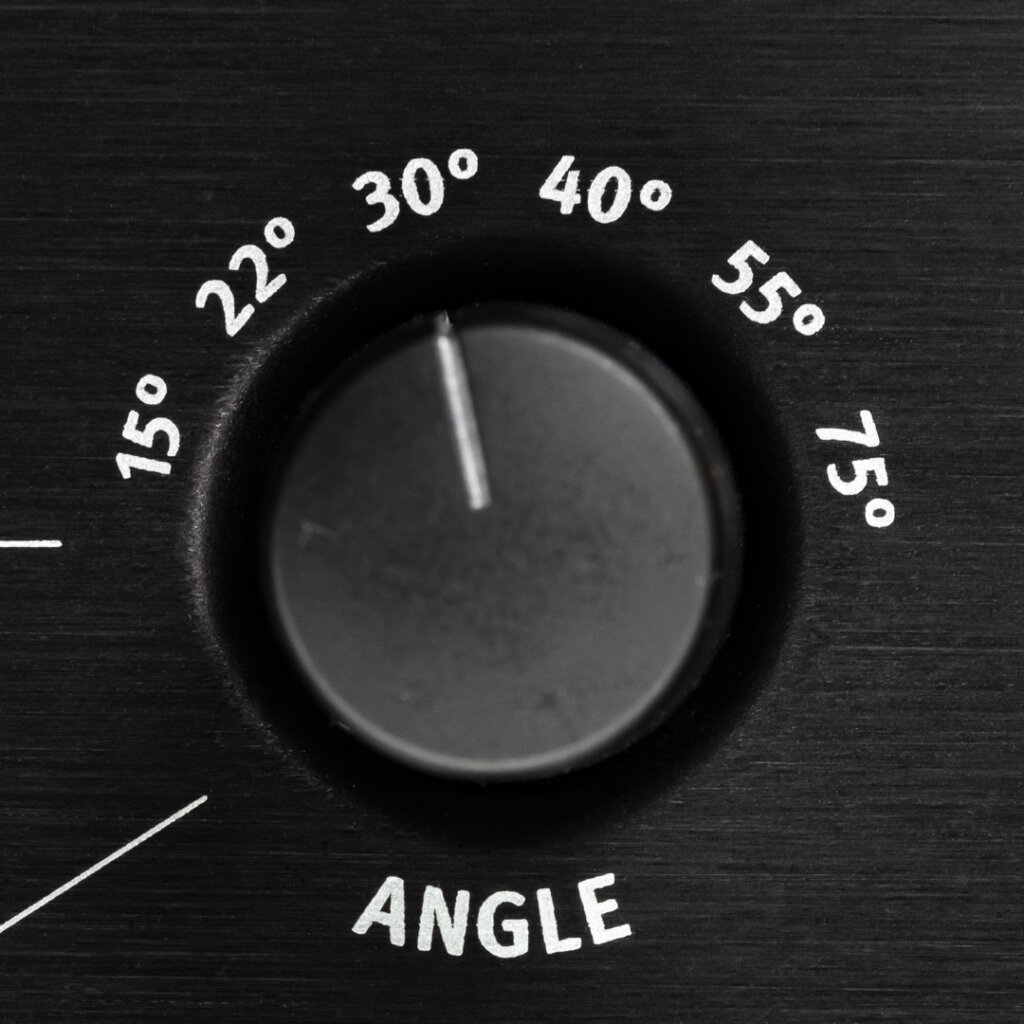
With the Angle switch you adjust the interaural time difference which is related to the placement of the speakers. The interaural time difference is frequency-corrected because the sound is reflected and absorbed by the head in a non-linear fashion.
During conventional listening on headphones, our brain can compensate a certain level of false playback representation – but this is very exhausting and leads to listening fatigue.
To make the listening experience even more perfect, the level of the center of the stereo image needs to be attenuated when the Phonitor Matrix is active. This ensures that not only the position of all sound sources is correct but also their volume.
In most Phonitor devices this value is set to a fixed
attenuation of -1 dB, which is the best choice for getting
an authentic representation of the sound stage.
Phonitor 3 DAC, designed for the most advanced mixing
and mastering applications, allows to adjust the center level in in fine steps of 0.3 dB or 0.4 dB with the
“Center” switch.
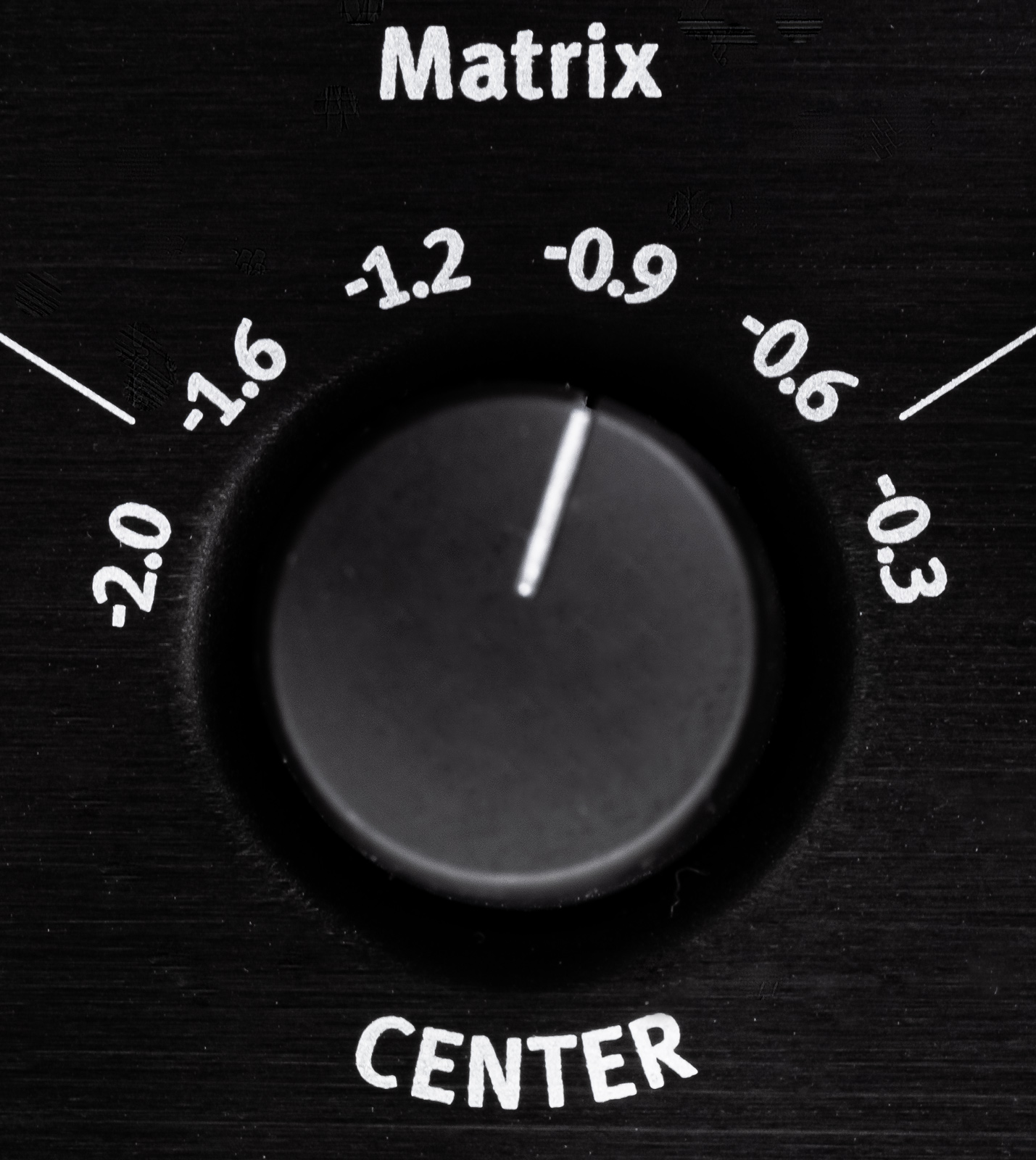
Center
When activated (Matrix switch = All) you control the intensity of the center signal with the Center switch. If the stereo width is narrowed through changes in Crossfeed and Angle (so as to correspond to your actual loudspeaker setup), the phantom center may likely sound too intense while mixing on headphones.
You normally would counteract by lowering the mid signals in the mix. However, listening to that mix on loudspeakers the phantom center appears to quiet.
Attenuating the center allows the center signal to be adjusted back to the appropriate ratio of volume in relation to the stereo signal when mixing on eadphones, so that the phantom center gains the correct volume in relation in relation to the stereo signal during speaker playback.
Summed up:
The SPL Phonitor Matrix corrects the false representation of the stereo sound image, which makes it much easier to find the right decisions for mixing and mastering engineers. The hifi enthusiast can experience the music, like it was originally mixed and recorded.
So nothing stands in the way of a successful and long mixing session on headphones.






